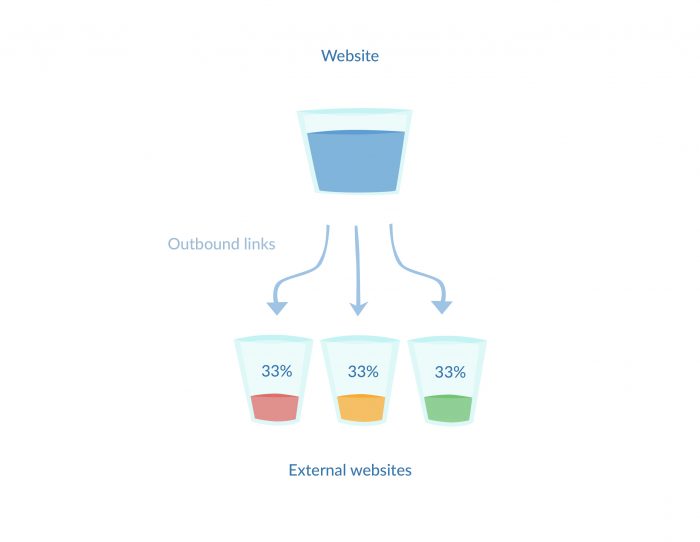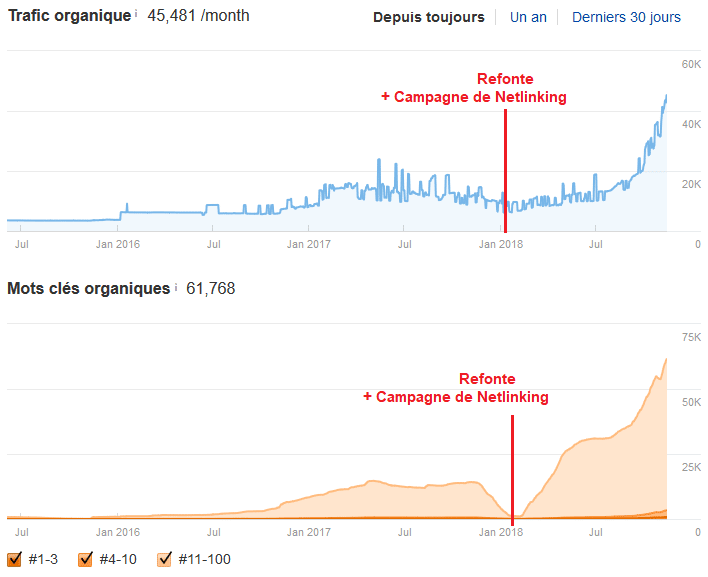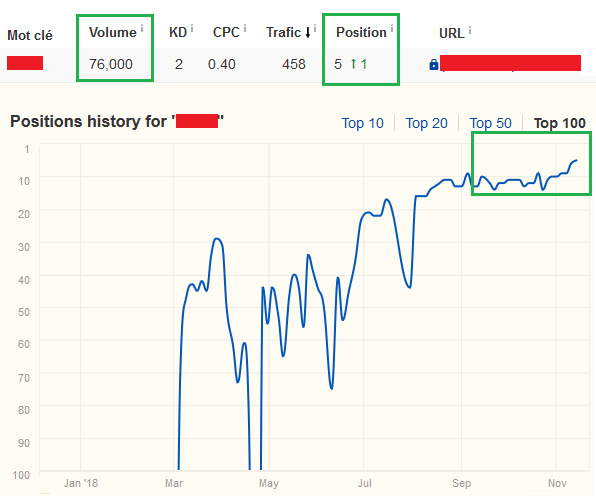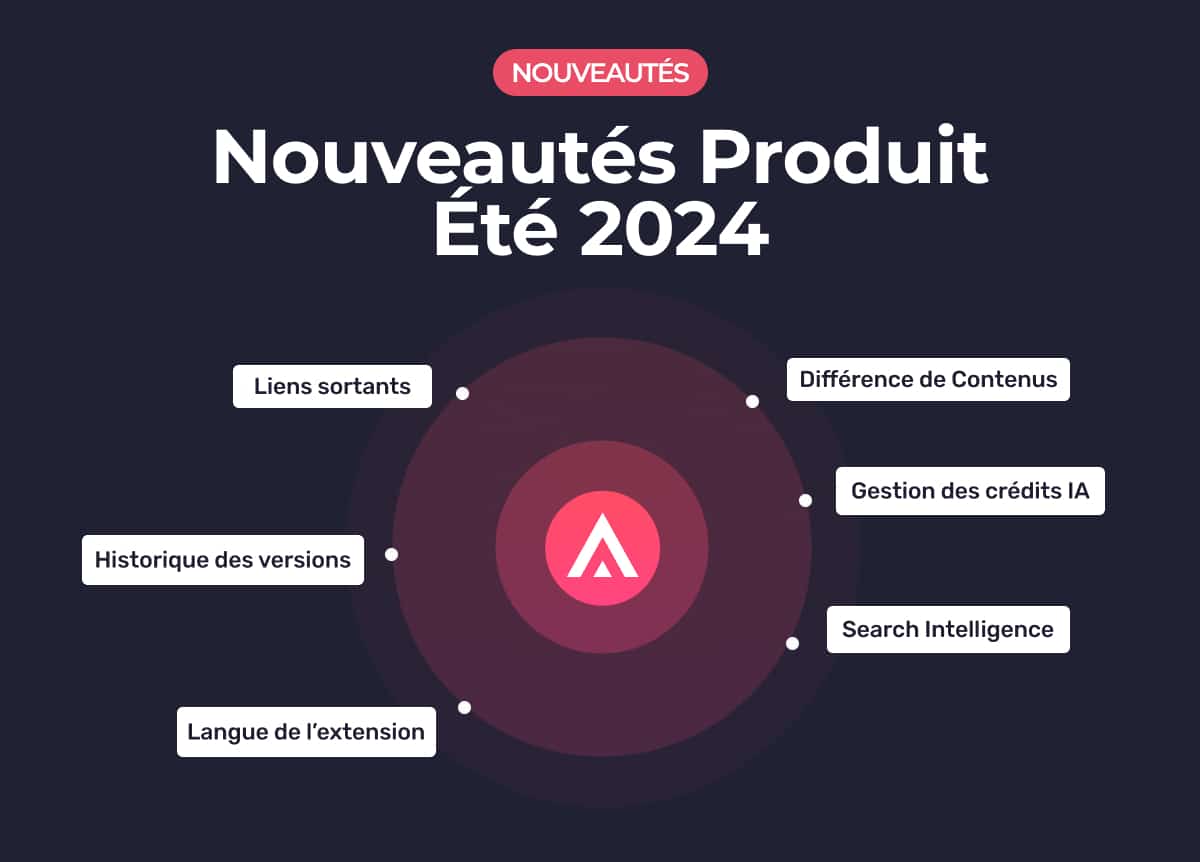When building your SEO strategy, the off-site part is as just important as your on-site SEO. Google has always given great importance to backlinks to determine a website’s authority and popularity. Keep in mind that netlinking is great at strengthening your SEO strategy! Here’s an overview of the different netlinking strategies and link types you should know and how to use them.
Definition of netlinking and link types
What is netlinking?
Links have always been important since the beginning of the Internet. By definition, the worldwide web is an interconnection of different networks, linked to each other by – links! Thanks to them visitors and robots can navigate between different contents, articles, webpages and websites.
In the real world, the reputation of a brand is based on how strong the word of mouth is in driving customers, the quality of the netlinking is the online equivalent.
Why is netlinking important in SEO?
Before getting started, it is important to understand why a netlinking strategy for your website is essential in terms of SEO. Netlinking consists in getting and/or creating links to other websites to strengthen the authority of a target website.
Google’s way of defining the ranking of websites is based on a simple observation: if a website with high authority talks about you, then your website wins in reputation and authority. By getting external links, your website will benefit from “SEO juice” which will be the basis of your reputation!

Growing your netlinking has several benefits impacting each other:
- Greater authority for Google;
- Improved website ranking on the SERP;
- Greater and qualified organic traffic;
- Increased brand awareness;
- Increased turnover!
Google guidelines are clear and precise on netlinking: “The ranking of a website in Google search results is partly based on the analysis of websites which include links to its pages. The quantity, quality and relevance of the links influence the ranking. The websites linking to these pages can provide information about the purpose of your website, and can reflect its quality and popularity.”
What are the differences between NoFollow and DoFollow links and what is their impact on a website’s netlinking?
These two types of links are used to tell robots which way to go when crawling a website and finding links. DoFollow is used to tell robots “Follow this link and take it into account”. NoFollow tells Google to ignore the link on an SEO level. When we talk about backlinks, we talk about DoFollow links, because we want them to be taken into account and add some value to our ranking.
Here’s how these links look like in HTML:
- DoFollow: <a href=”https://semji.com/fr/blog”>Blog de Semji</a> ou <a href=”https://semji.com/fr/blog” rel=”dofollow”>Blog de Semji</a>
- NoFollow: <a href=”https://semji.com/fr/blog” rel=”nofollow”>Blog de Semji</a>

In your netlinking strategy make sure to set your links as “DoFollow” if you want to get some of their juice. Keep an eye out for links pointing at your website with little to no relation with your topic, as it can negatively impact your SEO. Here are two solutions to prevent this:
- reject the links you don’t have control over via the Search Console;
- switch links to NoFollow if you have access to the code.
When building your netlinking strategy, you will have to balance NoFollow and DoFollow links. To get a look at the current situation, you can perform an analysis on the type of links in your netlinking, you can use Ahrefs, Majestic or SEMrush, among others.
Apply the same care in your search for backlink partners: make sure the targeted websites also follow a good DoFollow link policy. If not, find another partner!
There’s a widespread belief in the SEO world that you should keep a few NoFollow links to make your link profile more legitimate. But at Semji, we honestly don’t believe this! Only 2% of websites worldwide have natural NoFollow links… NoFollow gives only a little bit of juice: it’s an open debate!
What is a natural backlink?
First and foremost, it is important to know that there are good and bad backlinks and different techniques for acquiring links, that are more or less risky.
Among all netlinking techniques, natural backlinks are preferred by Google and therefore the most efficient and cheapest! A natural backlink is obtained naturally (as its name implies) when a website, blog or online user decides to talk about you because they enjoy your content, your services or your products. This type of link has no cost commitment (financial, return link, sending a product etc.). Backlinks obtained naturally are the only ones authorized, as specified by Google in “Link Systems”. The Mountain View company warns: any technique aimed at creating artificial links will be severely punished.
The three characteristics of a good backlink
To define the quality of a backlink, different elements have to be considered:
- the origin of the backlink, which will determine its strength: semantic and topic consistency, reputation, authority, ranking etc.
- the link’s anchor and the words surrounding it: the anchoring text must contain some strategic keywords, without doing over-optimization. The words before and after the anchor must, ideally, be semantically close to the anchoring text;
- the position in the content hierarchy: is the link located on a page close to the home page? Above the fold?
Keep in mind that with natural backlinks, you cannot control this!
What’s the best ratio of optimized anchors for a strong netlinking strategy?
Finding the perfect ratio in an anchor text is a very important but often forgotten part of your SEO strategy. By using the right ratio of anchors in your netlinking strategy, you can, not only avoid a penalty, but you can also easily win valuable positions on the SERP, so why miss out on it?
Here are our recommendations:
- 3% MAX of the total number of links must include anchors optimized on your business’s strategic keywords;
- 5% MAX of the number of anchors designed for long tail;
- The rest of the anchors, i.e. 92% of the rest of the backlinks, is to be shared between plain URLs and URL variations, the brand name and various slightly optimized anchors like “Click here”, “Visit our website”, “Find out more” etc.
By optimised anchors, we mean anchoring texts on which everyone tries to position themselves, especially via Adwords.
To build a strong and powerful anchoring strategy, pay close attention to those of your competitors by analyzing all the websites ranking on the first page on your main keyword. Then, analyse the anchoring texts of the different pages using Majestic, for example, and get the average for each category of anchors, this will give you an idea of the SERP temperature on the percentage of anchors to use.
What about internal netlinking?
When talking about netlinking, most of the time we talk about external links, therefore backlinks, which are pointing at the website. However, internal netlinking is also important. Also called internal linking, internal netlinking allows robots to browse your different contents and understand its logical and semantic links.
Although backlinks are a great source of opportunities for your SEO, they are nonetheless in Google’s firing line since many SEO experts have abused from it. So be careful, because a strategic error, the wrong partner, a sudden acquisition of links or over-optimized anchors could be damaging to your website.
Since 2012, the Penguin algorithm has not been cutting any slack. Many websites have been penalized because they had too many backlinks of poor quality! The algorithm takes into account several criteria to determine whether a website has an “acceptable” netlinking strategy according to Google:
- link anchors
- the authority of the referring domains
- the website’s theme and pages
- the frequency at which a website obtains new links
- the ratio between NoFollow and DoFollow links
- the spread of Top Level Domains
- Sitewide links present in the header, footer, sidebar etc.
Different netlinking strategies
To build a powerful netlinking strategy, you can (and should) use several techniques. The goal is to find the right balance and to stay natural to avoid the wrath of the Penguin algorithm — while building a strong and diverse link profile as quickly as possible.
Guest Blogging: boosting your SEO thanks to bloggers’ notoriety
Guest Blogging can be extremely profitable in terms of SEO as long as your website shares a common interest with the guest. This technique consists in building partnerships with influential bloggers on topics that are close or complementary to yours. You need to identify an influencer and invite them to write content that will be posted on your website under their own name, and then to do the same on their website. This partnership should be win-win.
Are you frequently contacted for Guest Blogging? Congrats! These invitations show that you’re a reference in your industry and that you’re in a position to negotiate the terms of the partnership.
Outside reciprocal links, it’s also possible to pay for Guest Blogging by exchange products or services. Of course, this won’t be possible with every businesses, but this kind of reward can apply to many domains. For example, it is possible to offer free products (cosmetics, food, transport etc.) or services (dinner at restaurant, hotel night, massage, sightseeing tour etc.) in exchange for a review on an influencer’s blog.
If your selection of partners is insightful and consistent, your website will attract new qualified visitors and your content will benefit from increase coverage on social media!
Content marketing: relying on linkbaiting with press contacts and influencers’ networks
Hard to implement and maintain, but very profitable in the long term: press contacts and linkbaiting are great ways to get natural backlinks. The strategy lies on the production of quality, original and unique content.
If you want to build your strategy on press contacts, be aware that it’s a long term job that will get you high quality links, but generally, in low quantity. You have no control over the recurrence of links or anchors, or targeting, but your links are 100% natural!
Advantages:
- Properly acquired links
- Quality semantic content
- Trust
Disadvantages:
- Low recurrence
- Anchor
- No/little targeting possible
- Time spent vs number of links obtained
There are two solutions open to you for linkbaiting:
- The first consists in doing self-promotion and posting content on your own networks in the hope of being naturally covered by press — and that can take a very long time…
- Second solution: contact the media directly in the hope of being published for free. Media websites have great statistics and are highly valuable to Google, as well as driving a large amount of traffic. But sponsored articles are usually very expensive, making this strategy difficult to implement if all the links have to be bought.
With influencers, you get the same benefits with a better targeted audience! The advantage of linkbaiting comes from the “snowball” effect that can happen very quickly with diverse and natural links.
Advantages:
- Potentially very efficient
- Quick
Disadvantages:
- Costly
- Forbidden by Google
- Difficult to get good quality
- Recurrence
Depending on your business industry, this method can be more or less risky. Some topics are better suited to “buzzwords” than others. Therefore you must provide content consistently to maintain popularity. Another method, which is the most qualitative: produce premium content to rank on strategic keywords over the long term. The aim is to become a reference in your industry and to regularly get new quality links. Being in a niche or in an industry in full growth can clearly make the task easier for you.
In any case, the production of high-quality marketing content is essential if you want to grow your strategy!
Creating manual links: a good method for a balanced link profile
Long and tedious, but free and under you control, creating links yourself can be very efficient too.
To grow your link building, you can search by criteria based on the Footprint concept. You first need to identify interesting platforms, forums, press release websites and blogs. Once you have done this research, all you have to do is leave a few links here and there… These links are easy to get and free, but their SEO impact remains relatively low.
For an efficient search using Footprints, you must fully understand the subtleties of Google search with Boolean operators.
Example of a Footprint:
- inurl: forum entitled: DIY website: fr
- intext: powered by WordPress intext: leave a comment
Advantages:
- Easy to obtain
Disadvantages:
- Positioning at the bottom of the article
- Website number in NoFollow
- Good idea, already overused
- Harder and harder to find
Another solution is to stay on the lookout for any mentions made of your website. It’s an excellent way to acquire new backlinks! Use Ahrefs and Mentions or simply Google Alerts to monitor what is being said on you and where. As soon as you identify a website which has mentioned you as a source, for one of your contents, a picture, an info-graphic, or any element that justifies having a backlink: contact the website’s webmaster and ask them to make a backlink to your website! The Google image search is also very powerful in listing websites and blogs. You can also take advantage of this opportunity to kindly suggest some anchor ideas that would work for you!
Last tip: use the potential of 404 pages! Identify all the pages that have backlinks but no longer exist. Then, use one of the two following solutions:
- set 301 redirections,
- contact the websites where the backlinks originate, and ask them to redirect to the URL of another close by page to redirect the juice.
Sponsored articles and link exchange: a quick rise to power for your target website
The purchase of sponsored articles is more intended to introduce your brand than to promote it aggressively. Fast and efficient, this technique can however quickly cost you a lot of money, and become very expensive… Prices range between 100€ and 3000€ for a backlink on a high authority website! If your website is recent, this technique will not be adapted. But if you have the budget, here are the solutions available to you:
- buy a sponsored article: contact the website(s) that interest you and negotiate your conditions;
- buy a sponsored article using a dedicated platform like Rocketlink, Getfluence or Reech. But platform decides on the prices.
No matter what, make sure you know what you’re paying for — the number of links in each articles, number of words, outsourced writing or not etc. Although the content is paid-for, there are often quite a few rules to comply with (editorial line, tone, form etc.).
However, be careful not to rush to a website that generates a lot of traffic. If this traffic is not qualified, you will certainly benefit from a new backlink, but probably not from new visitors on your website, even less from conversions!
Although expensive, this method allows you to get visibility on a high profile website that would not have been accessible otherwise. Let’s face it: most of the big influential websites don’t post content for free anymore, even if they are original, unique, relevant and related to the topic… Business is business.
Advantages:
- Can be very efficient
- Quick
Disadvantages:
- Costly
- Forbidden by Google
- Difficult to get good quality links
- Little to no recurrence
If your website has good statistics (Trust Flow, Citation Flow etc.), think about doing link exchanges! That will allow you to save money and to feed your blog with new content: it’s a win-win situation! Though, be careful not to use this technique too often as Google might find out…
Build a blog network from expired domain names
This tactic requires a certain amount of investment at the beginning, but once set up, it will allow you to clearly grow your netlinking strategy and fully control your links’ anchors, the words and phrases surrounding your anchors, as well as the frequency of acquiring new backlinks.
A Private Blog Network (PBN) is a blog ecosystem going from 20 to 300 websites set up using expired domain names. By buying back the names of strategic domains, you can benefit from their reputation… and from all the backlinks acquired by the previous websites! The aim of this technique is to redirect as many links as possible to your target website, also called the Money Website, to give it as much visibility as possible.
Although a PBN can be very efficient, it needs to be handled with caution. The different satellite websites should not only be used to make backlinks to your website; they require a regular supply of content and must be treated carefully on many aspects:
- choice of keyword families,
- choice of target pages,
- anchor spread,
- quality and themes of domain names,
- choice of IPs and hosting companies,
- creating a PBN to span over the medium/long term etc.
This technique is rather for people who have in-depth SEO expertise to guarantee PBN efficiency over the long term. Uncontrolled, your network of websites can quickly produce the opposite effect. It is also possible to be supported by SEO experts to better manage this strategy.
Advantages:
- Manage anchors, decide of destination pages
- Dedicated juice
- Manage all possible risks
- Scalable
- Highly efficient
- Adaptable
- Gets better and better over time
- Endless strategies
Disadvantages:
- Many technical prerequisites to follow
- Infrastructure management
- Its cost if “home-made”
- Decisive, demanding strategy
Here’s an overview of a website in the “Automotive” industry with around 50 pages — netlinking started in October 2016:

Development of a keyword position:

The key ingredients for an efficient and juicy netlinking strategy!
You now know the different netlinking techniques available. Now, let’s have a look at the best practices to build a quality link profile which applies to each technique described above:
- ONLY go with relevant, topic-related websites for your business to strengthen your website’s semantic relevance. Irrelevant backlinks are at best useless and at worse detrimental to your SEO.
- Always analyze the Trust Flow and Citation Flow, using Majestic and Spam Score with Moz before doing link acquisition. These tools give valuable insights, but the results should be taken with a bit of perspective. The same goes for the acquisition of expired domain names: it is essential to check that mistakes or harmful SEO actions have not been made in the past.
- Standard directories and link farms should be avoided: these techniques of massive link acquisition used to work, but not anymore! A few good quality directories (Trust Flow of at least 20 and Citation Flow of at least 30) can host your links, but don’t over-use them!
- Keep a good ratio between optimized and non-optimized anchors
- Prefer complex link exchange arrangements to mutual or three-way links whenever possible, to better leverage the SEO juice of each.
As often (always?), going for quality over quantity remains the best advice! A bad backlink can be more harmful than useful for your SEO and reduce to nothing all your SEO efforts!
How do you do netlinking in 2021?
Netlinking is a real art! As discussed in this article, there are different ways to do netlinking: linkbaiting, press relations, guest-blogging, PBN, ninja linking, paid linking… The goal is to achieve the right balance between these different techniques. But no matter which one you go for — be very careful if you do it yourself, and surround yourself with the right contractor if you outsource this project.
Yet, netlinking is essential, and even a necessity in SEO — it would be a shame to miss out on it!
As a strategic element in SEO, a good netlinking strategy can greatly improve the ranking of your website on the SERP, and therefore increase traffic, and sales! Do you want to get help in building the perfect netlinking strategy for your website? Our SEO agency can create the perfect netlinking strategy for you. Contact us!

